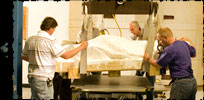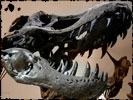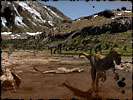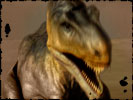National Geographic Channel
Dinosaurs
A Night of Dinosaur Discoveries
Dino Death Trap–Sunday, Dec. 9 at 8P et / 9P pt
Dino Autopsy–Sunday, Dec. 9 at 9P et / 10P pt
Dissecting a Dinosaur Mummy
By William Lee
Peering inside a massive hunk of rock that contains a near-complete dinosaur body requires one of the largest CT Scanners on the planet.

Block of rock containing the Edmontosaurus dino-mummy fossil is carried by a front-loader.
Back in 1999, a high school sophomore named Tyler Lyson spotted three dinosaur vertebrae poking out of the ground on his family’s land in North Dakota. Lyson was no ordinary teenager, but rather a paleontological prodigy who already had 20 dinosaur fossil finds to his credit. But it wasn’t until he returned to excavate the site five years later that he discovered that this one was no ordinary fossil. When he broke off a piece of the surrounding rock, he noticed an unusual pattern, which he initially thought might be a piece of an ancient plant. Instead, when he cleaned the sample back in his lab, he realized that it was an impression of the dinosaur’s scaly skin, shaped as if it was still part of the animal.
“Occasionally we’re very lucky and get a partial skeleton and in exceptional circumstances we get a complete skeleton articulated”
“That was really a thrill,” he recalls. “I knew there were other examples of smaller invertebrates being encased and the soft tissue being preserved. I figured that a significant portion of the animal might be out there in the rock.”
Indeed, Lyson had discovered what paleontologists suspect may be a virtually complete specimen of an Edmontosaurus, a three-and-a-half ton, 40-foot-long herbivore that roamed the wetlands that existed 67 million years ago in what is now the dusty, dry North Dakota badlands. Not just the skeleton, but fossilized remains of soft tissue as well, mummified by a mysterious process that scientists are still working to understand. It was an unprecedented find, one that had the potential to rewrite the existing body of knowledge not just about duckbills, but dinosaurs in general.

Scanning a Dino Mummy
Scientists and technicians attempt to scan ‘Dakota’ the Edmontosaurus.
Watch Video »
“Occasionally we’re very lucky and get a partial skeleton and in exceptional circumstances we get a complete skeleton articulated,” explains Phil Manning, head of the paleontology program at the University of Manchester in the UK, who is leading the effort. “That is the absolute ten out of ten for a dinosaur. Dinosaur mummies come in off the scale. These are so rare.”
Dakota, as the duckbill has been named, offers paleontologists a tantalizing chance to examine, for the first time, a near-complete three-dimensional specimen with muscle, skin and other organs intact–the closest we’ll ever come to a living dinosaur, outside of computer-generated ones in the movie Jurassic Park. To unlock Dakota’s secrets, scientists are employing an array of cutting edge technology, ranging from high-resolution three-dimensional laser mapping to recreate the environment in which it lived, to PET scanning of skin samples taken from the mummy in an attempt to identify proteins. They’ve excavated and transported the five-ton hunk of rock that encases the dinosaur mummy and transported it from North Dakota to a Boeing aerospace facility near Los Angeles, where scientists are subjecting it to the biggest and most difficult CT scan ever attempted.
The dinosaur mummy hasn’t been willing to yield its secrets easily. The autopsy has turned out to be an exceedingly difficult project, one in which scientists have had to endure numerous frustrating setbacks and summon every last bit of their ingenuity. While it remains a work in progress, the study of Dakota already has yielded significant new insights about the giant creatures who once ruled the planet. And at last, the team may be on the verge of a breakthrough that could reveal even more.
at Boeing use the largest CT-Scanner on the planet. But will this high-stakes, high-tech paleontology work?



